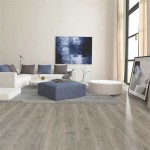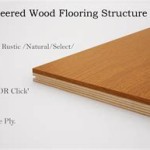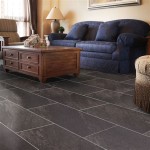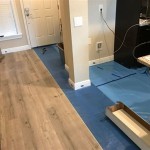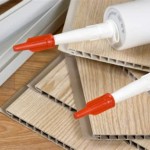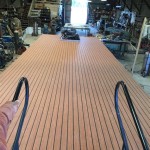Waterproof Vinyl Flooring: Achieving the Ceramic Tile Look
Waterproof vinyl flooring that mimics ceramic tile has become a popular choice for homeowners seeking a durable, aesthetically pleasing, and practical flooring solution. This material offers the visual appeal of ceramic tile without the associated drawbacks like grout maintenance, coldness underfoot, and susceptibility to cracking. Understanding the various types of waterproof vinyl available, its advantages, and its installation methods is crucial for making an informed decision.
The term "waterproof vinyl flooring" generally encompasses several types of resilient flooring, primarily Luxury Vinyl Plank (LVP) and Luxury Vinyl Tile (LVT). These products are engineered with multiple layers, including a wear layer, a decorative layer, a rigid core, and often an attached underlayment. The wear layer, typically made of clear polyurethane with added protectants, shields the flooring from scratches, scuffs, and stains. The decorative layer is a high-resolution printed image that provides the visual of ceramic tile, stone, wood, or other materials. The rigid core, often made of WPC (Wood Plastic Composite) or SPC (Stone Plastic Composite), provides stability and waterproof properties. The attached underlayment adds cushioning and sound absorption.
The allure of waterproof vinyl flooring that looks like ceramic tile lies in its ability to replicate the texture, color variations, and even the grout lines associated with real ceramic. Advanced printing technology and embossing techniques allow manufacturers to create highly realistic visuals. Furthermore, the waterproof nature of the material makes it ideal for installation in moisture-prone areas such as bathrooms, kitchens, and basements, where ceramic tile is traditionally used.
Key Advantages of Waterproof Vinyl Tile Flooring
One of the primary reasons for the popularity of waterproof vinyl tile is its superior water resistance. Unlike natural wood or laminate flooring, vinyl is inherently waterproof, meaning it will not swell, warp, or rot when exposed to moisture. This characteristic makes it a practical choice for areas prone to spills, leaks, or high humidity. The rigid core construction further enhances its stability and resistance to water damage.
Compared to ceramic tile, waterproof vinyl offers a warmer and more comfortable surface underfoot. Ceramic tiles are typically cold to the touch, especially in colder climates, and can be unforgiving to stand on for extended periods. Vinyl, on the other hand, provides a softer and more cushioned feel, making it a more comfortable option for living spaces. Some vinyl options also come with an attached underlayment, which further enhances comfort and sound absorption.
Installation of waterproof vinyl tile is generally simpler and faster than installing ceramic tile. Ceramic tile requires meticulous preparation, precise cutting, and expert application of mortar and grout. Waterproof vinyl, on the other hand, often comes in interlocking planks or tiles that can be easily installed using a click-lock system or with peel-and-stick adhesives. This ease of installation can save time and money, especially for DIY enthusiasts. Moreover, vinyl requires less subfloor preparation compared to ceramic, reducing the overall project complexity.
Types of Waterproof Vinyl Tile Imitating Ceramic
Two primary types of waterproof vinyl flooring are commonly used to imitate ceramic tile: Luxury Vinyl Plank (LVP) and Luxury Vinyl Tile (LVT). While both offer similar benefits, there are subtle differences in their construction and appearance.
Luxury Vinyl Tile (LVT) is specifically designed to mimic the look of ceramic tile, stone, or other hard surfaces. It typically comes in square or rectangular tiles and can be installed with or without simulated grout lines. LVT offers a wide range of design options, allowing homeowners to create realistic ceramic tile patterns. Some LVT products even feature textured surfaces that replicate the feel of natural stone or tile. The sizes of LVT tiles can vary widely, allowing even greater flexibility in design and installation.
Luxury Vinyl Plank (LVP), while primarily designed to resemble hardwood flooring, can also be used to mimic elongated ceramic tiles or even stone slabs. LVP typically comes in long, narrow planks and is often installed with a click-lock system. Although LVP is less commonly used to directly replicate square ceramic tiles, its versatility allows for creative installations that can achieve a similar aesthetic. The longer planks can simulate large-format ceramic tiles, providing a modern and seamless look.
The choice between LVT and LVP for a ceramic tile look depends on the desired aesthetic and the specific dimensions of the space. LVT is generally preferred for replicating traditional ceramic tile patterns, while LVP can be a viable option for a more contemporary or minimalist design.
Considerations Before Installation
Before installing waterproof vinyl flooring, thorough assessment of the subfloor is essential. The subfloor must be clean, level, and dry to ensure proper adhesion and prevent future problems. Any imperfections, such as cracks or unevenness, should be repaired before beginning the installation. Uneven subfloors can cause the vinyl to flex and potentially damage the locking mechanisms over time, leading to gaps and instability.
Acclimation is another important factor to consider. Allowing the vinyl planks or tiles to acclimate to the room's temperature and humidity for at least 48 hours before installation can prevent expansion or contraction after installation. This ensures a more stable and long-lasting flooring surface. The acclimation period allows the material to adjust to the specific environmental conditions of the room, minimizing the risk of warping or buckling.
The choice of installation method depends on the type of vinyl flooring and the condition of the subfloor. Click-lock systems are relatively easy to install and require no adhesives, while peel-and-stick options offer a quicker but potentially less durable solution. Glue-down installations provide the most secure and long-lasting bond, but they require more careful preparation and specialized adhesives. Professional installation is recommended for glue-down applications to ensure proper adhesion and avoid potential issues.
When selecting waterproof vinyl flooring that looks like ceramic tile, it is crucial to consider the wear layer thickness. The wear layer is the top protective layer that shields the flooring from scratches, scuffs, and stains. A thicker wear layer provides greater durability and resistance to wear and tear, making it a better choice for high-traffic areas. Wear layers are typically measured in mils (thousandths of an inch), and a wear layer of 12 mils or higher is recommended for residential applications, while commercial applications may require a wear layer of 20 mils or more.
Furthermore, understanding the importance of matching the right underlayment according to the subfloor conditions or even acoustic insulation is imperative. The underlayment will heavily support the vinyl tiles. This is also to ensure comfort, reduce noise, and add thermal resistance. If the pre-attached underlayment isn’t sufficient, it may be necessary to incorporate an additional layer dependent on the thickness and its specifications.
Maintaining waterproof vinyl flooring that looks like ceramic tile is relatively simple. Regular sweeping or vacuuming removes dirt and debris, while occasional mopping with a mild detergent and water keeps the surface clean. Avoid using abrasive cleaners or harsh chemicals, as they can damage the wear layer. Promptly wiping up spills prevents staining and water damage. With proper care and maintenance, waterproof vinyl flooring can provide years of beauty and performance.
Durability and Longevity
The durability of waterproof vinyl flooring is a significant factor in its popularity. High-quality vinyl flooring can withstand heavy foot traffic, impacts, and everyday wear and tear. The rigid core construction provides excellent dimensional stability, preventing warping or buckling. The wear layer protects the decorative layer from scratches and stains, ensuring that the flooring maintains its appearance for many years.
Proper installation plays a critical role in the longevity of waterproof vinyl flooring. A well-prepared subfloor and correct installation techniques ensure that the flooring is properly supported and protected from moisture and movement. Following the manufacturer's instructions and using appropriate adhesives or locking mechanisms are essential for maximizing the lifespan of the flooring.
The lifespan of waterproof vinyl flooring can vary depending on the quality of the product, the level of foot traffic, and the maintenance practices. However, with proper care and maintenance, high-quality vinyl flooring can last for 15-20 years or even longer. Investing in a durable and well-maintained vinyl floor can provide a cost-effective and long-lasting flooring solution.

Bathroom Vinyl Flooring Carpetright

Grey Tile Effect Anti Slip Vinyl Flooring For Kitchen 2 0mm Thick Sheet Waterproof Lino

Celestial Marble Tile 6 5mm Spc Lvt Flooring
Adura Max Luxury Vinyl Flooring Tiles Mannington

Waterproof Vinyl Flooring The Bathroom Showroom

Black Tile Effect Anti Slip Vinyl Flooring For Kitchen 2 0mm Thick Sheet Waterproof Lino

White Ivory Stone Effect Non Slip Contract Commercial Waterproof Vinyl Flooring With 2 8mm Thickness

Is Vinyl Plank Flooring Waterproof Twenty Oak

Waterproof Vinyl Flooring From Leading Supplier Wifi Ceramics

Stone Rigid Core Vinyl Tile Flooring Queen Beige Magicstone Step Guard Floors
Related Posts


